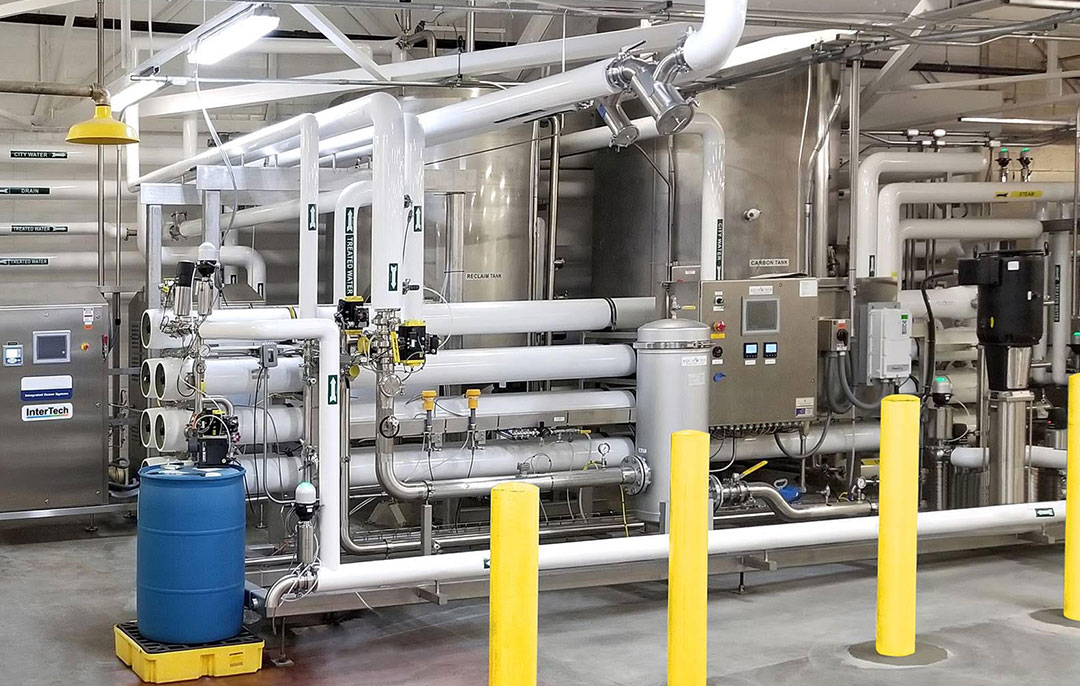InterTech (ITL) has worked on perfecting scalable cost-efficient dissolved ozone application designs and installation plans for our clients. Our ozone experience is a key differentiation factor that helps ITL maintain its leadership role in process design.
Ozone applications are fascinating. Applied correctly, ozone can be a powerful and safe disinfectant for many food and beverage applications.
Dissolved ozone can even be a cost-effective replacement or supplement for some traditional sanitation CIP applications, especially when microorganism counts are the primary concern or when microorganism counts return too quickly after repeatedly applying chemical treatments.
To clean food and beverage systems and related piping, ozone gas is dissolved in water, similarly to how carbonated drinks are made. This ozone-dosed water is circulated throughout the system, sanitizing it without anyone needing to handle external chemicals or monitor the cleaning process.
Because ozone application systems can generate their own ozone from oxygen in the air, additional sanitation chemicals are not required. This results in lower operating material and labor costs.
Why Is Ozone Effective?
Ozone is effective because it is highly reactive. Ozone (O₃) wants to become a more stable molecule such as oxygen (O₂). The mismatched O₃ molecular bonds do not last long. When ozone comes into contact with microorganisms, ozone degrades into oxygen, creating short-lived peroxides in the process.
These compounds turn back into water after physically destroying pathogenic and nonpathogenic microorganisms in a way that scrubbing with surfactants alone cannot accomplish.
For example, dissolved ozone is effective against the pathogenic cryptosporidium organism that has begun to develop a resistance to other disinfectants.
Another example is nonpathogenic organisms that reside in piping systems for long periods of time. Colonies of microorganisms cover themselves in “armor” that looks like an opaque to clear gelatinous sludge that we affectionately refer to as goo from the movie Aliens.
This armor is a defense against chemical treatments that typically only wash away the armor leaving organisms behind to continue growing. Hence, high counts return rapidly. Whereas, ozone removes both the armor and the organism.
Is Dissolved Ozone Safe to Use?
When applied properly, dissolved ozone is safe to use in process systems. If allowed into the air, ozone gas has a distinctive smell. This odor is strong enough that it is noticeable well before it becomes a safety concern.
Design safeguards, including ambient ozone detectors and programming interlocks, are put in place to ensure that atmospheric ozone is automatically detected well before it is humanly detectable.
Safety and automation features are another core component of the scalable ozone application and integration design developed and used by ITL in the integration of ozone systems. Inherently safe valve configurations, proper sensor layouts, and careful material selection all contribute to a well-designed system requiring minimal operator intervention.
A properly designed ozone application system can be left running unattended during plant shutdowns or other CIP-like outages. This is in contrast to a CIP system, which typically requires monitoring to ensure specific concentrations and temperatures are met.
A useful consequence of ozone reactivity is that over time ozone naturally decays quickly into oxygen. This means that ozone does not carry the contamination risks associated with other chemical disinfectants, where fumes linger indefinitely until ventilated.
The Role of UVC Light
Additionally, ozone degrades even faster in the presence of high-energy ultra violet (UVC) light. This sensitivity to UVC light is one reason that UVC systems are often employed as ozone destruction devices in tandem with the ozone applications.
By alternating the use of UVC light and ozone, ITL designs water systems in a way that eliminates residual ozone in process water during production operations.
UVC light has been used in process water systems for decades to reduce microbial loads in process water, including COVID-19. Using UVC and ozone in tandem strengthens the plant’s antimicrobial arsenal.
Final Thoughts about Dissolved Ozone
Dissolved ozone is a valuable sanitation tool that is incredibly effective. One example of an excellent application was a reverse osmosis (RO) water system that ITL integrated and installed.
Our client struggled with reoccurring high microbial counts. Traditional chemical treatments were ineffective, focusing on cleaning microbial buildup without eliminating the source organisms.
Repeated automatic flushing of the system with ozone-dosed water effectively solved the problem, allowing our client to keep their system clean without additional chemical applications and resources.
The UVC sanitizing system now serves a dual purpose, which creates a valuable economy of scope since the UVC system can both sanitize process water during operations and destruct ozone at the end of ozone runs.
InterTech (ITL) is happy to assist with your unique process design needs and develop robust solutions. We are always happy to help!

Let us show you how InterTech will improve your operating efficiencies and increase your profitability
InterTech brings clients value by performing plant engineering services with integrity, skill and efficiency. Our specialty is working within existing facilities to optimize line design for space and efficiency.


0 Comments